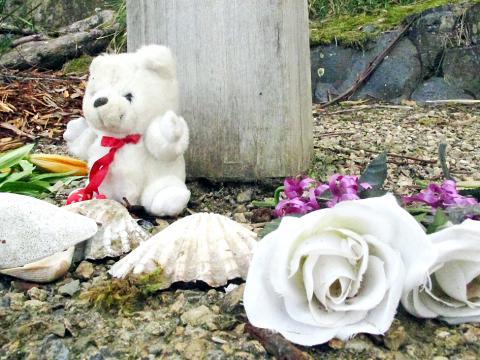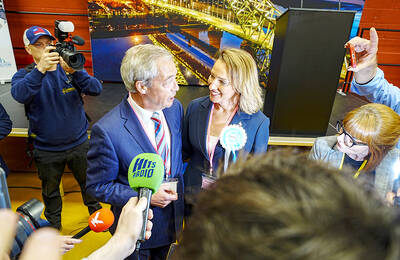Carolyn Loughton still carries a bullet in her shoulder from one of the world’s worst mass shootings that killed her daughter 20 years ago and galvanized Australia to drastically clamp down on guns.
Loughton threw her body over her 15-year-old daughter Sarah, but could not save her from a gunman with two semi-automatic assault rifles who methodically took headshots in a Port Arthur, Tasmania, cafe on April 28, 1996, killing 35 people.
In response, the Australian government severely restricted ownership of semi-automatic firearms, pump-action shotguns and other rapid-fire weapons. It also bought back about 700,000 guns from the public at a cost of US$390 million.

Photo: AP
Since then, the country has experienced only one case that meets the generally accepted definition of a mass shooting — four deaths in a single event — a 2014 incident in which a farmer shot his wife and three children before killing himself.
EXEMPLARY LAWS
A person living in the US is about 10 times more likely to be killed by a gun than in Australia, and US President Barack Obama has held up Australia’s strict gun laws as a good example after repeated mass shootings in the US.
As Australia approaches the 20th anniversary of the Port Arthur tragedy — to be remembered with a ceremony on Thursday — there is renewed debate over guns amid a review of the landmark National Firearms Agreement, adopted after the 1996 attack, and the loosening of some gun-related regulations.
The review was recommended after a government inquiry into the December 2014 Sydney cafe siege that left two people and the gunman dead. Gun enthusiasts fear that any changes to the agreement could mean greater restrictions on gun ownership, while gun control advocates say the country is backsliding on its restrictions.
Taking center stage in the debate is whether Australia should import the Adler A110 shotgun, a Turkish-manufactured lever-action weapon that can fire eight cartridges in as many seconds. That is almost as fast as a pump-action shotgun.
ILLEGAL OWNERSHIP
Loughton, now 60, sees the Adler question as a tipping point. She is speaking out for the first time to protect the country’s stringent gun laws.
“I’ve probably got 20 years of my life left. I wouldn’t have thought that I would ever have to go down this track,” Loughton said. “But I have seen and I know more than anybody should ever have to experience, and on my last breath on my last day, I don’t want to say I could have done something.”
Pro-gun activists say that Australia’s real problem is illegal guns. They say that the Islamic State-inspired gunman in the Sydney cafe siege, Man Haron Monis, never held a gun license and his sawed-off pump-action 12-gauge shotgun had not been registered. Authorities could not trace where Monis had obtained it.
Australian Senator David Leyonhjelm, a vocal gun proponent, say that Australians have become “disarmed victims.”
Loughton and gun control advocates say they see the erosion of gun controls. They point to relaxed requirements to establish the legitimate need for a gun and decisions by several states to waive a 28-day waiting period for a gun owner to apply for a permit to own more than one weapon.
‘DEVASTATING IMPACT’
Unlike in the US, Australians do not have a constitutional right to bear arms and personal protection is not recognized as a “genuine reason” required by law to own a gun.
Many say that what sets the Adler shotgun apart is a promotional video that focused on how quickly its magazine could be emptied. The video attracted a lot of attention from gun enthusiasts and horrified opponents.
In August last year, the government blocked imports of the eight-shot Adler pending the outcome of the firearms review.
Gun Control Australia, an advocacy group, said allowing the weapon to be imported “will have a devastating impact on Australia’s strong gun laws.” The group’s concerns include that the Adler’s short lever action makes it quicker to reload than other guns in its class, a claim the gun’s Australian importer denies.
Australian Senator Bridget McKenzie, who last year formed the Parliamentary Friends of Shooting group, said it is important to “have some serious methodology behind the decisions we’re making rather than, ‘oh, that looks scary, therefore it must be bad.”’
CIRCUMVENTING THE BAN
In the meantime, thousands of five-shot versions of the Adler have been sold in Australia with minimum restrictions.
Gunsmiths are already increasing the Adler’s magazine capacity to 10 cartridges and more. In a breakdown in Australia’s harmonized gun laws, the extended magazines are legal in all states except in New South Wales, the most populous.
“I can make them as big as you want,” gunsmith Nik Halliwell said of the Adler magazine capacity. “If you want a 100-shot lever action, in theory, it’s possible to do.”
Gun advocates say that the Adler should be available to category A license holders, the least restrictive and most common license.
However, Loughton and other activists say both versions of the gun should be available only to the much more restrictive category C and D licenses that are reserved for farmers, professional shooters and government agencies.
Sydney University gun policy analyst Philip Alpers said the shotgun had been imported to fill a gap in the Australian market created by the Port Arthur bans.
“Whenever a firearm type is restricted, the arms industry does its best to circumvent the law,” he said.
Many regard Australia’s stricter gun laws as former Australian prime minister John Howard’s greatest legacy. However, in a recent television interview even Howard said he was concerned the country’s gun laws were “fraying at the edges.”
Critics say that Howard’s gun buyback was futile and point to evidence that there are now more guns in Australia that there were before the 1996 massacre.
ZERO-SUM GAME
A Sydney University study found in 2013 that 1.05 million firearms had been legally imported into Australia since the 1997 buyback — about the same number as had been collected under that program, a later buyback of handguns as well as numerous gun amnesties, court-ordered seizures and voluntary returns of weapons since 1988.
That shows, gun advocates say, that there is no link between the number of guns in a country and the frequency of mass shootings.
Opponents disagree, saying that the big difference is that rapid-fire weapons are no longer freely available.
Criminologists generally agree that the National Firearms Agreement has reduced gun homicides. There is also evidence that it had reduced suicides, accidental gun deaths and gun crime.
Port Arthur, a collection of prison ruins that are remnants of Tasmania’s bleak past as a British penal colony, is to mark the anniversary with a ceremony attended by many of the victims’ family members.
The shooter, Martin Bryant, 28 at the time of the attack, was sentenced to 35 life terms without possibility of parole. He is now a maximum security inmate at Risdon Prison in Tasmania.
Adrian Kistan wonders if the father he lost in the Port Arthur massacre would be alive today if stricter gun laws had been in place at the time.
He takes some comfort that the tragedy led to changes.
“We take some degree of hope to think that ... out of such a terrible, terrible incident where people have lost their lives and families have been scarred because of it, well at least some good came of it,” he said. “Because there was a change in gun laws that controlled the manner in which firearms are dealt with in Australia.”

Kehinde Sanni spends his days smoothing out dents and repainting scratched bumpers in a modest autobody shop in Lagos. He has never left Nigeria, yet he speaks glowingly of Burkina Faso military leader Ibrahim Traore. “Nigeria needs someone like Ibrahim Traore of Burkina Faso. He is doing well for his country,” Sanni said. His admiration is shaped by a steady stream of viral videos, memes and social media posts — many misleading or outright false — portraying Traore as a fearless reformer who defied Western powers and reclaimed his country’s dignity. The Burkinabe strongman swept into power following a coup in September 2022

TRUMP EFFECT: The win capped one of the most dramatic turnarounds in Canadian political history after the Conservatives had led the Liberals by more than 20 points Canadian Prime Minister Mark Carney yesterday pledged to win US President Donald Trump’s trade war after winning Canada’s election and leading his Liberal Party to another term in power. Following a campaign dominated by Trump’s tariffs and annexation threats, Carney promised to chart “a new path forward” in a world “fundamentally changed” by a US that is newly hostile to free trade. “We are over the shock of the American betrayal, but we should never forget the lessons,” said Carney, who led the central banks of Canada and the UK before entering politics earlier this year. “We will win this trade war and

‘FRAGMENTING’: British politics have for a long time been dominated by the Labor Party and the Tories, but polls suggest that Reform now poses a significant challenge Hard-right upstarts Reform UK snatched a parliamentary seat from British Prime Minister Keir Starmer’s Labor Party yesterday in local elections that dealt a blow to the UK’s two establishment parties. Reform, led by anti-immigrant firebrand Nigel Farage, won the by-election in Runcorn and Helsby in northwest England by just six votes, as it picked up gains in other localities, including one mayoralty. The group’s strong showing continues momentum it built up at last year’s general election and appears to confirm a trend that the UK is entering an era of multi-party politics. “For the movement, for the party it’s a very, very big

The Philippines yesterday slammed an “irresponsible” Chinese state media report claiming a disputed reef in the South China Sea was under Beijing’s control, saying the “status quo” was unchanged. Tiexian Reef (鐵線礁), also known as Sandy Cay Reef, lies near Thitu Island, or Pagasa, where the Philippines stations troops and maintains a coast guard monitoring base. Chinese state broadcaster CCTV on Saturday said that the China Coast Guard had “implemented maritime control” over Tiexian Reef in the middle of this month. The Philippines and China have been engaged in months of confrontations over the South China Sea, which Beijing claims nearly in its